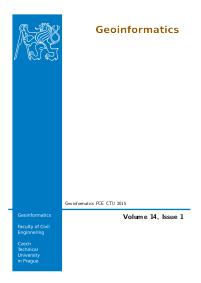Evaluation of gravity field model EIGEN-6C4 by means of various functions of gravity potential, and by GNSS/levelling
DOI:
https://doi.org/10.14311/gi.14.1.1Keywords:
Gravity field models, EGM 2008, Eigen-6C4Abstract
The combined gravity field model EIGEN-6C4 (Förste et al., 2014) is the latest combined global gravity field model of GFZ Potsdam and GRGS Toulouse. EIGEN-6C4 has been generated including the satellite gravity gradiometry data of the entire GOCE mission (November 2009 till October 2013) and is of maximum spherical degree and order 2190. In this study EIGEN-6C4 has been compared with EGM2008 to its maximum degree and order via gravity disturbances and Tzz part of the Marussi tensor of the second derivatives of the disturbing potential. The emphasis is put on such areas where GOCE data (complete set of gradiometry measurements after reductions) in EIGEN-6C4 obviously contributes to an improvement of the gravity field description.
GNSS/levelling geoid heights are independent data source for the evaluation of gravity field models. Therefore, we use the GNSS/levelling data sets over the territories of Europe, Czech Republic and Slovakia for the evaluation of EIGEN-6C4 w.r.t. EGM2008.
References
Bruinsma SL, Förste Ch, Abrikosov O, Lemoine J-M, Marty J-Ch, Mulet S, Rio M-H, Bonvalot S (2014) ESA’s satellite-only gravity field model via the direct approach based on all GOCE data, Geoph. Res. Lett., DOI 10.1002/2014GL062045
Bucha B, Janák J (2013): A MATLAB-based graphical user interface program for computing functionals of the geopotential up to ultra-high degrees and orders, Computers & Geosciences, 56, p. 186-196.
Denker H, Barriot J-P, Barzaghi R, Fairhead D, Forsberg R, Ihde J, Kenyeres A, Marti U, Sarrailh M, Tziavos I N (2008) The Development of the European Gravimetric Geoid Model EGG07. Institut für Erdmessung, Leibniz Universität Hannover, Schneiderberg 50, D-30167 Hannover, Germany.
Förste C, Bruinsma S, Abrykosov O, Lemoine J-M, et al (2014) Tha latest combined global gravity field model including GOCE data up to degree and order 2190 of GFZ Potsdam and GRGS Toulouse, 5th GOCE User Workshop, Paris 25 – 28 Nov. 2014
Floberghagen R, Fehringer M, Lamarre D, Muzi D, Frommknecht B, Steiger C, Pineiro J, da Costa A (2011) Mission design, operation and exploitation of the gravity field and steady-state ocean circulation explorer mission, J Geod 85: 749–758, doi: 10.1007/s00190-011-0498-3SATELLTE.
Kalvoda J, Klokočník J, Kostelecký J, Bezděk A (2013) A. Mass distribution of Earth landforms determined by aspects of the geopotential as computed from the global gravity field model EGM 2008. Acta Univ. Carolinae-Geogr., 48, 17-25. ISSN 0300-5402.
Klokočník J, Kalvoda J, Kostelecký J, Bezděk A (2013) Gravity Disturbances, Marussi Tensor, Invariants and Other Functions of the Geopotential Represented by EGM 2008, Presented at ESA Living Planet Symp. 9-13 Sept. 2013, Edinburgh, Scotland. Publ. in: August 2014: J Earth Sci. Res 2, 88–101.
Kostelecký J, Cimbálník M, Čepek A, Douša J, Filler V, Kostelecký J. jr., Nágl J, Pešek I, Šimek J (2012) Realization of S-JTSK/05. Geodetický a kartografický obzor 58/100, 7, 145–154 (in Czech).
Pavlis NK, Holmes SA, Kenyon SC, Factor JK (2008) EGM2008: An overview of its development and evaluation, National Geospatial-Intelligence Agency, USA, presented at conference: Gravity, Geoid and Earth Observation 2008, Chania, Crete, Greece, 23–27 June.
Pavlis NK, Holmes SA, Kenyon SC, Factor JK (2012) The development and evaluation of the Earth Gravitational Model 2008 (EGM 2008), J Geophys Res 17: B04406, doi:10.1029/2011JB008916.
Reigber C, Luehr H, Schwintzer P (2002) Goce gravitational gradiometry. J Geod 85:777–790. doi:10.1007/s00190-011-0500-0
Shako R, Förste C, Abrikosov O, Bruinsma SL, Marty J-C, Lemoine J-M, Flechtner F, Neumayer KH and Dahle C.(2013), EIGEN-6C: A High-Resolution Global Gravity Combination Model Including GOCE Data, in F. Flechtner et al. (eds.), Observation of the System Earth from Space – CHAMP, GRACE, GOCE and future missions, Advanced Technologies in Earth Sciences, DOI: 10.1007/978-3-642-32135-1_20, Springer-Verlag Berlin Heidelberg 2013
Zeman A, Kostelecký J, Kostelecký J jr, Ryšavý V (2007) Vertical component of the Earth's surface movement in the region of Central Europe (Czech Republic) from the results of satellite geodesy methods and their comparison with the results of repeated terrestrial geodetic methods. Poster presentation at the AGU 2007 Fall meeting.
Downloads
Published
Issue
Section
License
- Authors retain copyright and grant the journal right of first publication with the work simultaneously licensed under a Creative Commons Attribution License that allows others to share the work with an acknowledgement of the work's authorship and initial publication in this journal.
- Authors are able to enter into separate, additional contractual arrangements for the non-exclusive distribution of the journal's published version of the work (e.g., post it to an institutional repository or publish it in a book), with an acknowledgement of its initial publication in this journal.
- Authors are permitted and encouraged to post their work online (e.g., in institutional repositories or on their website) prior to and during the submission process, as it can lead to productive exchanges, as well as earlier and greater citation of published work (See The Effect of Open Access).

